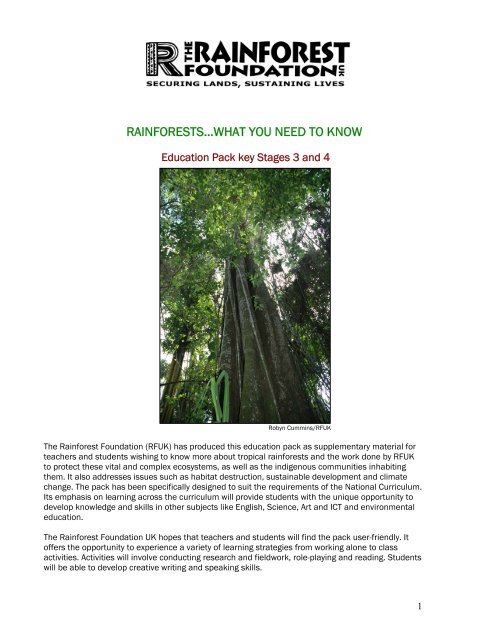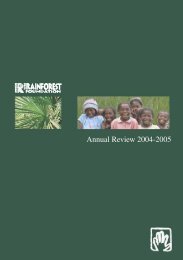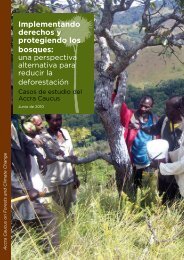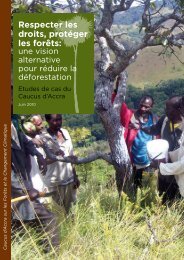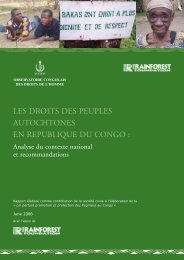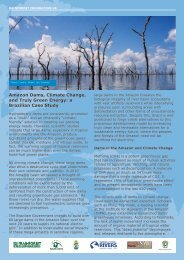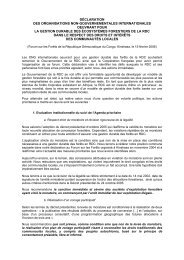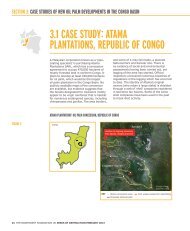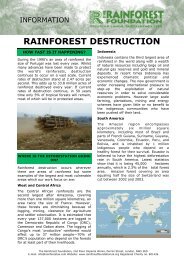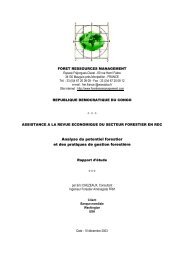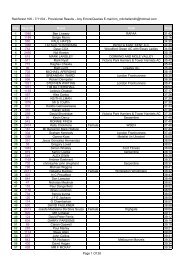rainforests…what you need to know - Rainforest Foundation UK
rainforests…what you need to know - Rainforest Foundation UK
rainforests…what you need to know - Rainforest Foundation UK
You also want an ePaper? Increase the reach of your titles
YUMPU automatically turns print PDFs into web optimized ePapers that Google loves.
RAINFORESTS…WHAT YOU NEED TO KNOW<br />
Education Pack key Stages 3 and 4<br />
Robyn Cummins/RF<strong>UK</strong><br />
The <strong>Rainforest</strong> <strong>Foundation</strong> (RF<strong>UK</strong>) has produced this education pack as supplementary material for<br />
teachers and students wishing <strong>to</strong> <strong>know</strong> more about tropical rainforests and the work done by RF<strong>UK</strong><br />
<strong>to</strong> protect these vital and complex ecosystems, as well as the indigenous communities inhabiting<br />
them. It also addresses issues such as habitat destruction, sustainable development and climate<br />
change. The pack has been specifically designed <strong>to</strong> suit the requirements of the National Curriculum.<br />
Its emphasis on learning across the curriculum will provide students with the unique opportunity <strong>to</strong><br />
develop <strong>know</strong>ledge and skills in other subjects like English, Science, Art and ICT and environmental<br />
education.<br />
The <strong>Rainforest</strong> <strong>Foundation</strong> <strong>UK</strong> hopes that teachers and students will find the pack user-friendly. It<br />
offers the opportunity <strong>to</strong> experience a variety of learning strategies from working alone <strong>to</strong> class<br />
activities. Activities will involve conducting research and fieldwork, role-playing and reading. Students<br />
will be able <strong>to</strong> develop creative writing and speaking skills.<br />
1
PURPOSE OF THE PACK<br />
The pack is intended <strong>to</strong> help students <strong>to</strong> develop:<br />
• Knowledge of the main characteristics of tropical rainforests.<br />
• Understanding of the complex processes taking place in the rainforest ecosystem.<br />
• Understanding of the importance of protecting rainforests and using them in a<br />
sustainable way.<br />
• Awareness of how their behaviour/action can either help <strong>to</strong> protect or destroy the<br />
rainforests.<br />
• Appreciation for the values and concerns of indigenous communities living in tropical<br />
rainforests.<br />
• Understanding that maintaining biodiversity in the rainforest is important for people,<br />
wildlife and the planet.<br />
• Knowledge` that human activities can have both positive and negative impact on<br />
rainforest ecosystems.<br />
• Appreciation for the work being done by the <strong>Rainforest</strong> <strong>Foundation</strong> <strong>UK</strong> <strong>to</strong> save the<br />
tropical rainforests of the world.<br />
• Understanding the link which exists between the <strong>to</strong>pic and other areas of the<br />
curriculum, such as citizenship, ICT, science and environmental education.<br />
• Ability <strong>to</strong> communicate their <strong>know</strong>ledge and understanding using geographical<br />
vocabulary in both speech and writing.<br />
• Enquiry skills such as conducting fieldwork.<br />
WHAT’S INSIDE?<br />
What are tropical rainforests?......................................3<br />
Where are rainforests located?....................................3<br />
Why protect rainforests?...............................................4<br />
Strata of tropical rainforests…………………………..…..….7<br />
<strong>Rainforest</strong> destruction…………………………………..……....9<br />
About the <strong>Rainforest</strong> <strong>Foundation</strong> <strong>UK</strong>…………..….........14<br />
<strong>Rainforest</strong> <strong>Foundation</strong> <strong>UK</strong> at work case studies….…….15<br />
Twenty things <strong>you</strong> <strong>need</strong> <strong>to</strong> <strong>know</strong> about rainforests…19<br />
Teaching and learning activities………………………..….20<br />
2
WHAT ARE TROPICAL RAINFORESTS?<br />
Tropical rainforests are very dense, warm, wet forests. They are<br />
abundant with many species of wildlife and vegetation. Today<br />
rainforests cover about 6% of the Earth’s land surface. They are the<br />
habitat <strong>to</strong> some 50-70% of all life forms on our planet. <strong>Rainforest</strong>s<br />
contain the most productive and the most complex ecosystems on<br />
earth. The plants of the rainforests generate contribute <strong>to</strong> the Earth’s<br />
oxygen. These plants are also useful <strong>to</strong> people in that they can be used<br />
in new drugs that may cure many of the world’s deadly diseases.<br />
WHERE ARE RAINFORESTS LOCATED?<br />
<strong>Rainforest</strong>s lie in the tropics, mostly in the area between the Tropic of<br />
Cancer (23.5◦ N Latitude) and the Tropic of Capricorn (23.5◦ S latitude).<br />
This band covers an area about 4800 km wide. Due <strong>to</strong> their location,<br />
rainforests receive a lot of sunlight and an abundance of rainfall, about<br />
400 <strong>to</strong> 1000 cm of rain each year. This creates the ideal conditions<br />
for rapid vegetation growth. The wide range of plants encourages a<br />
huge variety of insects, birds and animals.<br />
<strong>Rainforest</strong>s cover 6% of the Earth’s<br />
surface. Simon Counsell/RF<strong>UK</strong><br />
The largest rainforests are found in:<br />
1. Brazil (South America)<br />
2. Congo Basin (Central Africa)<br />
3. Indonesia (Southeast Asia)<br />
4. In Hawaii, the Islands of the Pacific, Caribbean and the Indian Ocean ( particularly in<br />
Madagascar)<br />
5. Australia<br />
3
WHY PROTECT RAINFORESTS?<br />
Preserving rainforests is of enormous benefit <strong>to</strong> humankind.<br />
<strong>Rainforest</strong>s are:<br />
• home <strong>to</strong> 50 million indigenous peoples,<br />
• a habitat for millions of species of plants and animals,<br />
• stabilising the world’s climate,<br />
• a source of medicines and foods,<br />
• and a source of other forest products<br />
HOME TO INDIGENOUS PEOPLES<br />
<strong>Rainforest</strong>s <strong>need</strong>s <strong>to</strong> be preserved not only for us and future generations. As well as being<br />
the home for countless species of animals and plants, the rainforest is also the home of<br />
many indigenous peoples. They have been living there for centuries and through time have<br />
developed the <strong>know</strong>ledge and skills <strong>need</strong>ed <strong>to</strong> survive sustainably in this environment. Their<br />
cultures and languages have survived for centuries. However, with the increasing exploitation<br />
of rainforest resources, the very survival of indigenous forest peoples is under threat.<br />
Indigenous forest communities like this one in the Democratic<br />
Republic of Congo have been protecting rainforests for<br />
centuries. Cath Long/RF<strong>UK</strong><br />
Recent studies have shown that<br />
indigenous cultures are<br />
disappearing at an unprecedented<br />
rate. It has been estimated that<br />
3,000 languages, (approximately<br />
half of the world’s languages) will<br />
disappear in the next century.<br />
Between 1900 and 1957 in Brazil<br />
alone, indigenous cultures declined<br />
from 230 <strong>to</strong> 87 by way of extinction.<br />
If nothing is done <strong>to</strong> protect<br />
indigenous peoples, their culture<br />
and <strong>know</strong>ledge will disappear. It is<br />
now well-<strong>know</strong>n that the <strong>know</strong>ledge<br />
of indigenous populations is of<br />
great value <strong>to</strong> the rest of the human<br />
race in regard <strong>to</strong> proper<br />
management of forests as well as<br />
life-saving medicines. A recent<br />
study found that the majority of useful plant based drugs used by people in the West were in<br />
prior use by indigenous communities.<br />
In many areas where deforestation is taking place, the rights of indigenous peoples are not<br />
being respected. They have suffered human rights abuses such as forced removal from their<br />
land, exploitation, violence, discrimination and environmental pollution. These abuses of<br />
basic human rights are against international laws. RF<strong>UK</strong> is campaigning <strong>to</strong> get the rights of<br />
rainforest indigenous people recognised and protected.<br />
4
STABILISE THE CLIMATE<br />
<strong>Rainforest</strong>s stabilise the world’s climate by absorbing carbon dioxide from the atmosphere.<br />
High levels of carbon dioxide in the atmosphere cause global warming. Destroying rainforests<br />
– is the second largest cause of global warming. So as more and more trees are cut down<br />
and burnt, the level of carbon dioxide in the atmosphere increases and contributes <strong>to</strong> the<br />
“green house effect”.<br />
<strong>Rainforest</strong>s also help maintain the water cycle. Through evapo-transpiration, plants release<br />
water in<strong>to</strong> the atmosphere, important for cloud formation. As vegetation is reduced, so there<br />
is little evapo-transpiration and therefore less water is released in<strong>to</strong> the atmosphere for<br />
recycling as rain. This can result in drier conditions in the areas affected.<br />
HABITAT FOR PLANTS AND ANIMALS<br />
Tropical rainforests are <strong>know</strong>n for their rich biodiversity. This means that they have a far<br />
greater number of different species of plants and animals than other natural habitats.<br />
Of the estimated 30 million species, there is the fear that up <strong>to</strong> 50,000 species a year could<br />
become extinct through rainforest destruction. Endangered species include mountain<br />
gorillas, chimpanzees, bonobos, giant ant-eaters, hyacinth macaws, giant otters, the giant<br />
Amazon River turtle, the Philippine eagle and jaguar.<br />
Many species currently found in<br />
tropical rainforests have not yet been<br />
studied by scientists. It is quite likely<br />
that many of them are of medical, as<br />
well as of economic value, <strong>to</strong><br />
humankind. Such is the case of a<br />
species of wild maize, recently<br />
discovered in the forests of southcentral<br />
Mexico. Its habitat was<br />
threatened with destruction by small<br />
farmers and commercial loggers. This<br />
wild maize offers resistance <strong>to</strong> four<br />
diseases which cause at least 1% loss<br />
<strong>to</strong> the world’s maize harvest each<br />
year, worth more than $500 million.<br />
Rare and endangered species like these bonobos inhabit<br />
the Congolese rainforests. Cath Long/RF<strong>UK</strong><br />
As for animals, a tropical forest<br />
species, the African green monkey,<br />
has a natural resistance <strong>to</strong> the AIDS<br />
virus. Recent studies carried out on<br />
the monkey has provided some clues<br />
that could help researchers develop a<br />
vaccine <strong>to</strong> cure the disease.<br />
5
SOURCE OF MEDICINES<br />
Tropical forest species contribute <strong>to</strong> our health <strong>need</strong>s.<br />
On average, one out of four medicines available on prescription – whether antibiotic,<br />
tranquilliser, laxative, or contraceptive pills, owes its origin <strong>to</strong> ingredients found in tropical<br />
rainforest plant species. Drugs obtained from rainforest plants are used <strong>to</strong> treat a number of<br />
diseases, such as cancer, malaria, heart disease, bronchitis, dysentery and tuberculosis.<br />
Some examples are:<br />
• A drug which is obtained from the Rosy Periwinkle, a plant which only grows in<br />
the rainforest of Madagascar, is used <strong>to</strong> treat certain forms of leukaemia;<br />
• The bark of Cinchona trees is used in the treatment of malaria;<br />
• The Mexican yam, Dioscorea, is used in the manufacture of many steroidal drugs<br />
currently in use, including the birth control pill.<br />
SOURCE OF FOODS<br />
Many products that we consume at home<br />
come from the rainforests. These include:<br />
• Spices (black pepper,<br />
cardamom, chilli, cinnamon,<br />
clove, ginger, nutmeg,<br />
turmeric and vanilla)<br />
• Nuts (Brazil nuts, macadamia,<br />
cashew and peanuts)<br />
• Fruits and vegetables<br />
(avocadoes, papayas, limes,<br />
mangoes, passion fruit,<br />
pineapples, guavas,<br />
grapefruit, coconut, sweet<br />
pota<strong>to</strong>es, okra, tapioca and<br />
sago)<br />
Caterpillars are a vital source of food for rainforest<br />
communities. ©Filip Verbelen<br />
Many indigenous peoples depend on wild<br />
foods as part of their diet. Caterpillars are<br />
a valuable source of protein for many<br />
people in the Congo Basin. Other foods<br />
such as wild plants, bushmeat, fish and<br />
honey are also eaten.<br />
6
SOURCE OF OTHER FOREST PRODUCTS<br />
Plant products<br />
Many industrial benefits are obtained from tropical forests species. Products like essential<br />
oils can be used in shampoo, soap, perfume, incense, cough drops, make-up, flavourings<br />
and drinks. Gums and resins are used <strong>to</strong> make products like chewing gum, Welling<strong>to</strong>n boots,<br />
paints, adhesives and varnishes.<br />
Non-timber products<br />
Aside from foods and medicines, tropical rainforests are also rich in non-timber products<br />
such as bamboo, rattan, and natural fibres like jute, sisal and ramie used in the production<br />
of furniture, floor coverings, baskets, bags, rope and clothing. Non-timber forest products<br />
provide a wealth of resources for both rural and urban dwellers in rainforest areas.<br />
Wood products<br />
Hardwoods from the rainforests, such as teak, mahogany, rosewood, balsa, sandalwood, and<br />
sapele are used for many purposes. These range from furniture, window sills, doorframes,<br />
flooring, <strong>to</strong>ys and kitchen utensils. As logging remains one of the major causes of<br />
deforestation, consumers should ensure that the timber they use comes from sustainably<br />
managed sources and not rainforests.<br />
STRATA OF TROPICAL RAINFORESTS<br />
Scientists divide the rainforests in<strong>to</strong> different<br />
strata (or zones). These strata differ in many<br />
ways including temperature, the amount of<br />
sunlight that they receive, the wetness of the<br />
environment, and the amount and types of life<br />
forms living in it.<br />
Starting from the <strong>to</strong>p four major zones can be<br />
identified and these are:<br />
EMERGENTS<br />
The emergent zone lies at the very <strong>to</strong>p of the<br />
rainforest trees. The tallest trees in the<br />
rainforest are usually over 50 metres high. It<br />
is the habitat for many birds and insects.<br />
CANOPY<br />
The canopy is the name given <strong>to</strong> the upper<br />
parts of the trees (about 20 <strong>to</strong> 40 metres tall).<br />
<strong>Rainforest</strong>s are divided in<strong>to</strong> four different strata.<br />
© www.rainforestplace.com<br />
7
It consists of a sea of leaves blocking out the sunlight preventing it from reaching the lower<br />
layers. The canopy contains over 50% of the rainforests’ wildlife. This include birds (like the<br />
scarlet macaw, the cuckoo, and the hornbill), mammals (like the howler monkey, and the<br />
orangutan) and reptiles (like snakes and lizards).<br />
Plants in the canopy include thick, snake-like vines and epiphytes (like mosses, lichens, and<br />
orchids) which grow on trees in search of the sunlight.<br />
UNDERSTORY<br />
The unders<strong>to</strong>ry is a dark, cool environment that is under the leaves but over the ground. This<br />
part of the rainforest has so little light that plant growth is severely limited. There are short,<br />
leafy, mostly non-flowering shrubs, small trees, ferns, and vines (lianas) that have adapted <strong>to</strong><br />
filtered light and poor soil. Examples of<br />
plants include ferns, palms, philodendrons<br />
and heliconias. Animals that live in the<br />
under s<strong>to</strong>ry include insects (like beetles<br />
and bees), arachnids, snakes, lizards, and<br />
small mammals (like the kinkajou) that<br />
live on tree bark. Larger animals like<br />
jaguars spend a lot of time on branches in<br />
the unders<strong>to</strong>ry, surveying the area, looking<br />
for prey.<br />
FOREST FLOOR<br />
<strong>Rainforest</strong> trees are often over 50 metres high.<br />
Kath Cochrane/RF<strong>UK</strong><br />
The forest floor is usually dark and damp.<br />
It contains a layer called litter which<br />
consists of rotting tree branches, leaves<br />
and dead animals. This decomposes<br />
rapidly <strong>to</strong> form a thin layer on the forests<br />
floor called humus, which is rich in<br />
nutrients. This zone of the rainforest is<br />
teeming with animal life, especially insects<br />
and arachnids (like tarantulas). People<br />
and the largest animals in the rainforests<br />
generally live here, including gorillas,<br />
anteaters, wild boars, tapirs and jaguars.<br />
HOW HAS THE VEGETATION ADAPTED TO THE CLIMATE?<br />
In tropical rainforests most trees have wide buttress roots. This provides support as the trees<br />
grow very tall in their search for sunlight. Lianas, (long woody climbing vines), grow around<br />
trees as they reach for the light. The leaves of many trees are waxy and have drip tips <strong>to</strong><br />
allow water <strong>to</strong> run off them (so that water does not gather on the leaves and cause them <strong>to</strong><br />
rot, it also allows water <strong>to</strong> reach the roots on the forest floor). Leaf stems are also flexible <strong>to</strong><br />
allow leaves <strong>to</strong> move with the sun <strong>to</strong> maximise pho<strong>to</strong>synthesis.<br />
8
RAINFOREST DESTRUCTION<br />
HOW FAST IS IT HAPPENING?<br />
Much has been done <strong>to</strong><br />
protect the world’s<br />
rainforests, but destruction<br />
still continues on a large<br />
scale. Every minute 50 acres<br />
of rainforest is destroyed --<br />
an area the size of England<br />
and Wales is lost every year.<br />
Deforestation is forcing<br />
indigenous forest<br />
communities out of<br />
rainforests; and plants and<br />
animals that used <strong>to</strong> live in<br />
them have either become<br />
extinct or must find a new<br />
habitat.<br />
Every minute 50 acres of rainforest is destroyed. Cath Long/RF<strong>UK</strong><br />
WHERE IS DEFORESTATION TAKING PLACE?<br />
The <strong>Rainforest</strong> <strong>Foundation</strong> works in the regions most affected by rainforest destruction:<br />
South America<br />
The Amazon region covers about six million square kilometres, including most of Brazil and<br />
parts of French Guiana, Surinam, Guyana, Venezuela, Colombia, Ecuador, Peru, and Bolivia.<br />
It is inhabited by 1 million indigenous people who depend on a healthy forest for their<br />
survival. Ecuador is believed <strong>to</strong> have the highest deforestation rate in South America. Latest<br />
statistics show that it is losing 45,000 hectares annually. Between 2002 and 2003, the<br />
Amazon forest lost an area almost half the size of Switzerland.<br />
West and Central Africa<br />
The Central African rainforests are the second largest after Amazonia, covering more than<br />
one million square kilometres, an area twice the size of France. However, these forests are<br />
shrinking because of logging, mining, clearance for agriculture and settlement. It is<br />
estimated that every year 10,000 sq km -- an area the size of Jamaica – are destroyed in the<br />
Congo Basin alone. Proposed logging in the Congo’s rainforest would affect up <strong>to</strong> 37 million<br />
people --70% of DRC’s population depend on the forests for at least part of their livelihoods.<br />
9
Indonesia<br />
Indonesia contains the third largest area of rainforest in the world along with lots of natural<br />
resources including large oil and natural gas reserves and mineral deposits such as gold.<br />
Recently the country has been through rapid political and economic changes. It is under<br />
increasing international pressure <strong>to</strong> speed up the exploitation of the natural resources in<br />
order <strong>to</strong> solve the country’s growing economic problems. However, large scale farming,<br />
plantations, mining and energy projects have brought few benefits <strong>to</strong> indigenous people who<br />
have been forced off their land.<br />
WHY IS DEFORESTATION TAKING PLACE?<br />
Humans are the main cause of<br />
deforestation.<br />
Forests are being cut down for many<br />
reasons:<br />
• wood for timber and for<br />
domestic uses<br />
• farming<br />
• road construction<br />
• settlement<br />
• mining<br />
• oil exploration<br />
• hydro-electric power<br />
Industrial logging deprives forest communities of their homes,<br />
livelihoods and cultures. © Filip Verbelen<br />
Wood for timber and domestic uses<br />
One of the main causes of rainforest destruction is logging. Many types of hardwood (such as<br />
mahogany, sapele and lauan) used for furniture, flooring and construction, are harvested<br />
from tropical forests in Africa, South East Asia and South America. Most of this timber is<br />
exported <strong>to</strong> the industrialised countries of the world. Countries like Japan and Britain are<br />
major importers of tropical hardwoods.<br />
Although loggers often select the most valuable trees and leave the rest, it is still very<br />
damaging <strong>to</strong> rainforests. Large trees are cut down and dragged through the forest, while<br />
access roads open up more forest lands <strong>to</strong> agriculture for poor farmers. In Africa, logging<br />
workers often rely on “bushmeat” for protein. They hunt wildlife like gorillas, deer and<br />
chimpanzees for food.<br />
10
Land for farming<br />
Every year large areas<br />
of rainforests are<br />
converted in<strong>to</strong><br />
farmland by<br />
commercial and<br />
subsistence farmers.<br />
Commercial farmers<br />
clear the land <strong>to</strong> set up<br />
huge banana and oilpalm<br />
plantations. In<br />
the Amazon, for<br />
instance, large parts of<br />
the rainforests are<br />
being converted in<strong>to</strong><br />
soybean farms.<br />
Swatches of the Amazon rainforest have been wiped out by soybean farms.<br />
Subsistence farmers in many parts of the world depend on rainforests <strong>to</strong> feed their families.<br />
Using the ‘slash-and-burn’ method of cultivation, they clear parts of the rainforest and farm it<br />
for a few years. After the land has lost its fertility they move on <strong>to</strong> a new patch of forest. This<br />
was once a sustainable method of farming, since the land had time <strong>to</strong> recover. However,<br />
<strong>to</strong>day with the increase in population it is having a destructive impact on rainforests.<br />
In Central and South America, rainforests are cleared <strong>to</strong> set up cattle ranches <strong>to</strong> produce<br />
beef for local consumption and also for export. In Central America, two-thirds of lowland<br />
tropical forests have been turned in<strong>to</strong> pasture since 1950. Cattle-ranching has turned Brazil<br />
in<strong>to</strong> a major exporter of beef. Besides raising cattle for food, many landowners, particularly<br />
in Brazil, use cattle <strong>to</strong> increase the size of their farms. By simply placing cattle on an area of<br />
forest land, farmers can gain ownership rights <strong>to</strong> that land.<br />
Road construction<br />
Road and highway construction in the<br />
rainforest opens up large areas for<br />
development. In Brazil, the Trans-<br />
Amazonian Highway has allowed easy<br />
access <strong>to</strong> the Amazon forest. This has<br />
resulted in the destruction of huge<br />
areas of the forest by poor settlers<br />
and loggers. In Africa, logging roads<br />
give access <strong>to</strong> poachers who hunt<br />
endangered wildlife.<br />
Industrial logging is one of the biggest threats <strong>to</strong> rainforests worldwide.<br />
Rosemary Brown/RF<strong>UK</strong><br />
11
Land for settlement<br />
The populations in many developing countries<br />
are increasing very fast and their<br />
governments want <strong>to</strong> build settlements in the<br />
rainforest. Trees have <strong>to</strong> be cut down <strong>to</strong> make<br />
space. For example, in Brazil, the government<br />
has cleared large parts of the Amazon<br />
<strong>Rainforest</strong> and encouraged landless people <strong>to</strong><br />
move there. The project has not been<br />
successful. Farmers stay on the same land<br />
and attempt <strong>to</strong> farm it year after year. The soil<br />
becomes infertile and nothing will grow.<br />
<strong>Rainforest</strong> destruction in Brazil ©Sue Cunningham<br />
Mining<br />
Some areas of the rainforest are rich in minerals such as gold, silver, iron ore, bauxite,<br />
copper and zinc. The exploitation of these minerals can benefit many poor countries as it<br />
helps them <strong>to</strong> pay their foreign debts. However, it has also resulted in the destruction of large<br />
parts of the rainforests <strong>to</strong> make way for roads and mines. Certain chemicals, such as<br />
mercury (used in gold mining) have contaminated rivers.<br />
Oil exploration<br />
Many rainforest areas of the world, particularly in South America and Africa, contain huge oil<br />
deposits. Underground tests carried out <strong>to</strong> locate the oil disturbs wildlife, and the cutting of<br />
tracks and routes for oil pipelines allows access <strong>to</strong> people wishing <strong>to</strong> clear and destroy the<br />
forests. Oil can contaminate the rivers and the soil. In 25 years of oil exploration in<br />
Ecuadorian Amazonia, it is estimated that 16.8m gallons of crude oil have leaked out of the<br />
oil pipelines.<br />
Hydroelectric power<br />
The abundance of rainfall and the existence of large rivers in tropical rainforests has led <strong>to</strong><br />
the development of hydroelectric power stations. The building of huge dams with large<br />
reservoirs has meant that large areas of land have been flooded resulting in the destruction<br />
of the ecosystem.<br />
12
WHAT ARE THE RESULTS OF TROPICAL DEFORESTATION?<br />
Tropical deforestation has a devastating impact on both the global and local environment:<br />
Global: Global Warming<br />
Deforestation is the second largest cause of global warming. <strong>Rainforest</strong> canopies absorb<br />
carbon dioxide. When the rainforests are burned and cleared, the carbon is released. When<br />
trees are cut down they can no longer absorb carbon dioxide. This means that there is more<br />
carbon dioxide, and carbon dioxide allows heat <strong>to</strong> travel through the atmosphere. However, it<br />
will not allow reflected energy <strong>to</strong> escape from the atmosphere. This is called the greenhouse<br />
effect and causes global warming.<br />
Local: Effects on rainforest communities, ecosystem loss and soil erosion<br />
• Destruction of the indigenous communities and their way of life.<br />
<strong>Rainforest</strong> communities are often the last <strong>to</strong> <strong>know</strong> that their<br />
lands have been assigned <strong>to</strong> logging companies. © Filip Verbelen<br />
• About 80% of nutrients<br />
that nourish rainforests<br />
come from trees and<br />
plants. The remaining<br />
20% is in the soil. The<br />
nutrients from the leaves<br />
that fall are recycled back<br />
in<strong>to</strong> the trees and plants.<br />
When a rainforest is<br />
cleared, conditions<br />
change very quickly.<br />
The soil dries up in the<br />
sun and when the rain<br />
comes, it washes the soil<br />
away. The rainforest<br />
never fully recovers.<br />
Wildlife and plant life is<br />
reduced. Biodiversity is<br />
lost. Soil erosion also<br />
leads <strong>to</strong> flooding as the<br />
soil is deposited on the<br />
river beds.<br />
WHO IS TO BLAME FOR TROPICAL DEFORESTATION?<br />
Everybody who in one way or the other depends on the rainforest shares the responsibility for<br />
its destruction. Local and national governments, poor farmers, multinational companies,<br />
commercial farmers, development agencies, logging companies and consumers all share the<br />
blame.<br />
• In many parts of the tropical rainforest, small farmers have been forced off their<br />
land in<strong>to</strong> poorer forest areas by commercial farmers.<br />
13
• Multinational oil, mining, and timber companies pay little attention <strong>to</strong> the call for<br />
them <strong>to</strong> exploit the resources of the rainforest in a sustainable way.<br />
• The governments of Less Economically Developed Countries (LEDCs) on the other<br />
hand, have not forced multinationals <strong>to</strong> respect their laws because they do not<br />
want <strong>to</strong> scare them away. They <strong>need</strong> <strong>to</strong> earn money <strong>to</strong> pay for the huge debts that<br />
they owe <strong>to</strong> More Economically Developed Countries (MEDCs).<br />
• International organisations concerned with development, such as the World Bank<br />
and the European Commission have funded projects which have led <strong>to</strong> the<br />
destruction of the rainforests.<br />
• Consumers. Many products that we buy contribute <strong>to</strong> rainforest loss, for example<br />
furniture made from tropical hardwoods like mahogany and sapele. The bananas<br />
that we consume come from plantations often located in areas that were once<br />
tropical rainforests.<br />
ABOUT THE RAINFOREST FOUNDATION <strong>UK</strong><br />
Our mission<br />
The <strong>Rainforest</strong> <strong>Foundation</strong> <strong>UK</strong> believes that the long-term protection of rainforests is linked<br />
with the rights of people living in those forests <strong>to</strong> land, food, shelter and medicines.<br />
The mission of RF<strong>UK</strong> is “<strong>to</strong> provide support <strong>to</strong> indigenous people and traditional populations<br />
inhabiting the world’s rainforests in their effort <strong>to</strong> protect their environment and fulfil their<br />
rights <strong>to</strong> land, life and livelihood.<br />
Our work<br />
The <strong>Rainforest</strong> <strong>Foundation</strong> <strong>UK</strong> works in partnership with local rainforest communities and<br />
non-governmental organisations.<br />
Locally, we assist communities <strong>to</strong>:<br />
• Secure their land<br />
• Continue <strong>to</strong> protect and manage their environment<br />
• Develop sustainable livelihoods<br />
Internationally we work <strong>to</strong> influence and change government policy and practices that<br />
undermine indigenous peoples’ rights and lead <strong>to</strong> further destruction of the rainforests.<br />
Founded in 1989, the <strong>Rainforest</strong> <strong>Foundation</strong> <strong>UK</strong> is one of three sister organisations<br />
(<strong>Rainforest</strong> <strong>Foundation</strong> US; <strong>Rainforest</strong> <strong>Foundation</strong> Norway) working in 16 countries. RF<strong>UK</strong><br />
works in the Congo Basin countries of Central Africa as well as in the Peruvian and<br />
Colombian Amazon.<br />
14
The <strong>to</strong>tal area of land saved and protected for indigenous peoples with the help of the<br />
<strong>Rainforest</strong> <strong>Foundation</strong> is 116,485 sq km. Plans are underway <strong>to</strong> protect a further 999,131<br />
sq km of rainforest – an area greater than the combined size of France, <strong>UK</strong> and Ireland.<br />
Where we work<br />
<strong>Rainforest</strong> <strong>Foundation</strong> <strong>UK</strong> <strong>Rainforest</strong> <strong>Foundation</strong> US <strong>Rainforest</strong> <strong>Foundation</strong><br />
Norway<br />
Peru Surinam Peru<br />
Colombia Ecuador Brazil<br />
Democratic Republic of Brazil<br />
Paraguay<br />
Congo (DRC)<br />
Congo Brazzaville Guyana Bolivia<br />
Cameroon Peru DRC<br />
Gabon<br />
Uganda<br />
Central African Republic<br />
Indonesia<br />
Malaysia<br />
Papua New Guinea<br />
RAINFOREST FOUNDATION <strong>UK</strong> AT WORK<br />
<strong>Rainforest</strong> <strong>Foundation</strong> <strong>UK</strong> Projects – case studies in the Democratic Republic of Congo, Peru<br />
and Cameroon.<br />
Case Study 1: The Democratic Republic of Congo (DRC)<br />
DRC is home <strong>to</strong> the second largest rainforest in the world. Currently the government controls<br />
and manages all the forest lands in the country. Some traditional cus<strong>to</strong>mary rights of the<br />
indigenous population are recognised locally, however, the economic interest of the state<br />
often takes priority, preventing these communities access <strong>to</strong> their land and resources.<br />
What are the threats <strong>to</strong> the rainforest in DRC?<br />
Unlike the rainforests of the Amazon and Borneo, the forests of DRC have not been largely<br />
affected by human destruction. But as the country begins reconstruction after many years of<br />
war, the forests are coming under a lot of pressure.<br />
already been handed out <strong>to</strong> commercial loggers. A <strong>to</strong>tal of 600,000 sq km – an area the size<br />
of France -- is at risk. Many indigenous communities who had lived there for centuries, such<br />
as Batwa ‘Pygmies’ were not consulted or even informed that their lands had been sold out<br />
from underneath them by the government.<br />
15
What RF<strong>UK</strong> is doing <strong>to</strong> protect DRC’s forests<br />
The Congolese Government is putting<br />
<strong>to</strong>gether a national plan using satellite maps<br />
<strong>to</strong> determine whether land will be used for<br />
conservation, commercial logging or<br />
community use. This is being done without<br />
consulting forest communities. RF<strong>UK</strong> -- along<br />
with 25 local partner organisations -- is<br />
working with more than 100 forest<br />
communities across DRC <strong>to</strong> create maps of<br />
their own land. So far about 3,000 sq km<br />
has been mapped and a further 60,000 sq<br />
km of indigenous rainforest land will be<br />
mapped by 2009. These maps will be used<br />
as a <strong>to</strong>ol by indigenous communities <strong>to</strong> show<br />
their presence in the rainforest so they can<br />
obtain land rights.<br />
Indigenous communities are creating maps like this<br />
showing their presence in the rainforest as a first<br />
step <strong>to</strong>wards gaining land rights.<br />
RF<strong>UK</strong>, in coordination with local partner<br />
organisations, has helped forest<br />
communities <strong>to</strong> investigate and report on the<br />
human rights abuses they suffer at the<br />
hands of logging companies.<br />
Indigenous peoples’ views are at last being heard in national and international debates<br />
following RF<strong>UK</strong>’s work with local organisations in DRC. The World Bank is reconsidering its<br />
strategy for ‘developing’ Congo’s rainforests after representatives of indigenous forest<br />
groups challenged its destructive policies. As a result, in 2007, the World Bank agreed for<br />
the first-time ever <strong>to</strong> consult Congo’s forest communities on the use of their rainforest lands.<br />
Case Study 2: Cameroon<br />
Cameroon has 16 million hectares of tropical rainforest which contains some of the richest<br />
biodiversity in the world. The country loses 1,000-2,000 sq km of rainforest every year.<br />
What are the threats <strong>to</strong> Cameroon’s rainforests?<br />
Commercial logging is the main threat <strong>to</strong> Cameroon’s rainforests. The country has an<br />
expanding timber industry which operates by selectively ‘harvesting’ areas of the rainforest.<br />
16
for a small number of hardwood species, especially sapele and utile. Most of the timber<br />
felled is exported <strong>to</strong> Europe. The country’s reliance on the timber trade has increased, thus<br />
putting more pressure on the rainforest.<br />
Deforestation is threatening the very<br />
existence of some indigenous<br />
communities such as the Baka, Bagyeli<br />
and Bakola ‘Pygmies’. Many ‘Pygmy’<br />
people are denied basic rights of<br />
citizenship. They do not possess identity<br />
papers, which mean that they cannot<br />
vote or have access <strong>to</strong> essential<br />
services like health care and education.<br />
Their traditional chiefs are not<br />
recognised by the government and their<br />
use of the forest is not recognised in<br />
Cameroonian law.<br />
<strong>Rainforest</strong> destruction in Cameroon is threatening the<br />
existence of forest communities like the Baka ‘Pygmys.’<br />
Rosemary Brown/RF<strong>UK</strong><br />
What is RF<strong>UK</strong> doing <strong>to</strong> save Cameroon’s rainforests?<br />
RF<strong>UK</strong> believes that the long-term protection of rainforests is strongly linked with the basic<br />
human rights of the peoples living in those forests. In Cameroon, projects assist ‘Pygmy’<br />
peoples <strong>to</strong> achieve greater social and economic independence by promoting their rights. The<br />
projects all include basic training about civil rights, how <strong>to</strong> obtain official documentation such<br />
as birth certificates and national identity cards, and how <strong>to</strong> use them. RF<strong>UK</strong> supports the<br />
development of local enterprises and community saving schemes, strengthening Baka<br />
community organisations, and promoting local culture.<br />
RF<strong>UK</strong> is also working <strong>to</strong> assist local communities in protecting the remaining undamaged<br />
rainforest in the area, by improving agricultural techniques, training, and the development of<br />
community forestry. The establishment of legally-recognised Community Forests enables<br />
local people <strong>to</strong> manage and control their forests, and will deter logging.<br />
Mapping of forest ‘terri<strong>to</strong>ries’ by Baka communities can demonstrate their long-term use of<br />
forest resources and presence in areas used for other, possibly conflicting, purposes such as<br />
commercial logging. RF<strong>UK</strong> supports participa<strong>to</strong>ry mapping by Baka people of the forests<br />
surrounding their settlements, which have traditionally been used for hunting and gathering.<br />
The community maps produced by communities in Djoum, Southern Cameroon, were the first<br />
that have ever been produced by indigenous peoples in a central African country.<br />
The Community Legal Field Workers in Cameroon are providing advice and training <strong>to</strong> forest<br />
communities on issues such as the prevention of illegal logging, establishing community<br />
forests, and ensuring that revenues from forest exploitation are returned <strong>to</strong> forest<br />
communities and spent on village development projects. They have also helped pioneering<br />
work in the official recognition of ‘Pygmy’ traditional chieftains and land rights.<br />
17
Case Study 3: Peru<br />
What are the threats <strong>to</strong> Peru’s rainforests?<br />
The Asháninka and Machiguenga peoples have<br />
lived in and protected the fragile Peruvian<br />
rainforest for the last 3,000 years. Their home is<br />
currently under threat by logging, oil and gas<br />
exploration, roads, illegal cocoa farms and the<br />
invasion of settlers.<br />
Some 70% of the Peruvian Amazon is currently<br />
slated for oil exploration.<br />
What RF<strong>UK</strong> is doing <strong>to</strong> save Peru’s rainforests?<br />
Since 1998, RF<strong>UK</strong> has been working with local<br />
partner ACPC <strong>to</strong> help local forest communities<br />
demarcate their lands and gain legal protection<br />
for them. To date, 1 million hectares of rainforest<br />
lands have been protected in indigenous<br />
reserves and a new national park.<br />
Asháninka peoples have lived in and protected<br />
Peru’s Amazon rainforest for centuries. ©Jaime<br />
Pena<br />
RF<strong>UK</strong> is working alongside the Asháninka and<br />
Machiguenga peoples <strong>to</strong> help them plan for<br />
themselves how their lands will be used, provide<br />
skills on defending themselves against timber<br />
companies and encourage them <strong>to</strong> have a role in<br />
the management of the new national park.<br />
18
RAINFORESTS: TWENTY THINGS YOU NEED TO KNOW<br />
1. <strong>Rainforest</strong>s once covered 14% of the earth’s land surface; now they cover about 6%.<br />
2. The largest area of rainforest in the world is found in South America (45%), followed<br />
by Africa (30%), Southeast Asia (16%), and Australia (9%).<br />
3. The Congo Basin contains the second largest rainforest on the planet after the<br />
Amazon.<br />
4. <strong>Rainforest</strong>s produce about 40% of the world’s oxygen .<br />
5. 50 acres of rainforest are lost every minute.<br />
6. Around 150,000 sq km of the tropical rainforest, equivalent <strong>to</strong> the size of England<br />
and Wales, is destroyed every year.<br />
7. In the 19 years since it’s founding in 1989, the <strong>Rainforest</strong> <strong>Foundation</strong> has protected<br />
116,485,000 square km.<br />
PEOPLE<br />
8. As many as 500 million people in tropical rainforests depend directly or indirectly on<br />
the forests for wild food resources, fresh water, building materials and natural<br />
medicines.<br />
9. 50 million have their homes in the rainforest.<br />
10. 80% of the world’s poorest people depend on the rainforest.<br />
NATURE<br />
11. <strong>Rainforest</strong>s contain about two-thirds of the world’s wildlife species.<br />
12. 50,000 wildlife species a year become extinct because of rainforest destruction.<br />
13. Tropical rainforests are the Earth’s oldest ecosystems. Within a four mile square area<br />
of a tropical rainforest, <strong>you</strong> would find:<br />
a. Over 750 species of trees<br />
b. 1500 different kinds of flowering plants<br />
c. 125 species of mammals<br />
d. 400 species of birds<br />
e. 100 reptiles<br />
f. 60 amphibians<br />
g. Countless insects<br />
h. 150 species of butterflies<br />
19
SCIENCE<br />
14. <strong>Rainforest</strong>s contain ingredients for medicines. An estimated one in four<br />
pharmaceuticals comes from tropical rainforest plants.<br />
15. While 25% of Western pharmaceuticals are obtained from rainforest ingredients, less<br />
than 1% of tropical plants have been tested by scientists.<br />
16. The U.S. National Cancer Institute has identified 3,000 plants that have the potential<br />
<strong>to</strong> cure cancer and 70% of these plants are found in the rainforest. Some 25% of the<br />
active ingredients in <strong>to</strong>day’s cancer-fighting drugs come from organisms found only in<br />
the rainforest.<br />
CLIMATE<br />
17. <strong>Rainforest</strong> destruction is the second largest cause of global warming.<br />
18. Deforestation creates more CO2 than all the cars, planes, trains and vehicles on<br />
Earth.<br />
19. Saving rainforests is one of the quickest and cheapest ways <strong>to</strong> help s<strong>to</strong>p climate<br />
change.<br />
20. If deforestation continues at the current rate, there will be no more rainforests by<br />
2050.<br />
TEACHING AND LEARNING ACTIVITIES<br />
1. Field work: Investigating a forest in <strong>you</strong>r local area.<br />
Organise a class visit <strong>to</strong> a forest in <strong>you</strong>r local area. Get students <strong>to</strong> identify and record the<br />
type of vegetation/animal species found there. Ask students <strong>to</strong> record any evidence of<br />
human activities taking place there (if there is any) for example, logging, farming and<br />
conservation work. Draw a labelled diagram of a cross-section of the forest. Back in the<br />
classroom students can discuss their findings.<br />
Ask students how rainforests are different from the forest <strong>you</strong> visited in <strong>you</strong>r local area. Ask<br />
them <strong>to</strong> describe what a tropical rainforest looks like. Where would <strong>you</strong> find one? What<br />
animals, birds and other creatures would <strong>you</strong> find there? What would it sound like? Who are<br />
the people that live there? Write students responses on a chart.<br />
2. Brains<strong>to</strong>rming activity: at home in the rainforest<br />
Ask students <strong>to</strong> bring different household things that originate from the rainforest, for<br />
example coffee, bananas and cinnamon. Encourage discussion about the importance of<br />
rainforests <strong>to</strong> them as consumers.<br />
3. Improve <strong>you</strong>r vocabulary<br />
Below is a list of key terms associated with the rainforest, find a suitable definition for each<br />
one of them: rainforest, biodiversity, species, ecosystem, indigenous, canopy, deforestation,<br />
emergent, endangered, equa<strong>to</strong>r, evaporation, extinct, greenhouse effect, global warming,<br />
logging, humus, nutrients, food web, unders<strong>to</strong>ry, strata. Use the new vocabulary in the<br />
activities that follow.<br />
20
4. S<strong>to</strong>ry writing<br />
Show the class a pho<strong>to</strong>graph of the rainforest. Ask the students <strong>to</strong> imagine what it would be<br />
like <strong>to</strong> live in the rainforest and ask them <strong>to</strong> write a s<strong>to</strong>ry. You could ask them <strong>to</strong> imagine they<br />
are being forced off their lands by loggers and how they would feel.<br />
5. Group work<br />
Divide the class in<strong>to</strong> groups. Ask each group <strong>to</strong> choose an indigenous group living in a<br />
rainforest area (Baka, Bagyeli, Batwa, Asháninka etc.)Using the library and the internet, find<br />
out:<br />
• Where they live<br />
• The kind of dress they wear (including jewellery)<br />
• Their everyday activities<br />
• Their diet<br />
• The language they speak<br />
• What types of human activities pose a threat <strong>to</strong> the existence of their indigenous<br />
group?<br />
• List five ways in which indigenous peoples use the rainforest<br />
Invite the students <strong>to</strong> make a collage with pictures and descriptions of their indigenous<br />
group.<br />
6. <strong>Rainforest</strong> Book<br />
Ask students <strong>to</strong> compile pictures of animals and plants that live in the rainforests. Use the<br />
pictures <strong>to</strong> make a rainforest book for the class. Students can add short notes on the<br />
animals and plants. This can be discussed in class.<br />
7. Making a face-mask<br />
Students can draw masks of different animals living in the rainforest. They then cut out the<br />
mask and colour it. Elastic or ribbon will be <strong>need</strong>ed <strong>to</strong> attach the mask on<strong>to</strong> the face. The<br />
students can wear the mask <strong>to</strong> act out a role-play.<br />
8. <strong>Rainforest</strong> under threat<br />
Look at the pho<strong>to</strong>graphs showing various human activities that pose a threat <strong>to</strong> the tropical<br />
rainforests in various parts of the world. Identify those activities. Using the ideas, information<br />
from the pack and other sources of information, write an article explaining <strong>to</strong> the general<br />
public the harmful effects that those activities can have on the tropical rainforests.<br />
9. Creative Writing<br />
a. Write a letter <strong>to</strong> the Prime Minister asking him what he is doing <strong>to</strong> help save rainforests.<br />
The Prime Minister, 10 Downing Street, London, SW1A 2AA<br />
b. Write a song or a poem about the rainforest.<br />
21
10. The rainforest food web<br />
Divide the class in<strong>to</strong> groups. Ask each group <strong>to</strong> choose a rainforest animal. Find out which<br />
other animals are linked <strong>to</strong> <strong>you</strong>r animal food chain. Draw those animals on cards. Using<br />
coloured pencils draw lines <strong>to</strong> link the different organisms <strong>to</strong>gether. All of this is put on a<br />
chart and link them with one another until <strong>you</strong> get a large rainforest food web showing how<br />
all the organisms are dependent on each other. Ask the students what will happen if one of<br />
the pieces goes missing. You can do this by crossing out one organism then rubbing out the<br />
lines linked <strong>to</strong> that organism, then all the lines linked <strong>to</strong> those organisms and so on.<br />
11. Making a model. Using recyclable materials ask students <strong>to</strong> make a model of the<br />
rainforest. The model should include the zones, plants, animals, and people that live there.<br />
12. In groups ask students <strong>to</strong> brains<strong>to</strong>rm on what they can do <strong>to</strong> save the rainforests. They<br />
can illustrate their actions on a spider diagram, which can be hung up on the wall of the<br />
classroom.<br />
13. Ask students <strong>to</strong> draw up a charter for the future of the world’s rainforests. It should<br />
include at least five ideas that will ensure the world’s forests survive for future generations.<br />
Present <strong>you</strong>r charter <strong>to</strong> the <strong>Rainforest</strong> <strong>Foundation</strong> <strong>UK</strong>. Your ideas may be incorporated on the<br />
organisation’s website.<br />
14. Trace a map of the world from an atlas. Mark and label the following lines:<br />
a. Equa<strong>to</strong>r b. Tropic of Cancer c. Tropic of Capricorn. On the map, shade in the main areas<br />
where tropical rainforests are found.<br />
15. Draw a diagram of the rainforest strata. Label the state and make <strong>you</strong>r own brief notes<br />
about the different zones found in rainforests.<br />
ACTIVITIES WITH THE RAINFOREST FOUNDATION <strong>UK</strong><br />
16. <strong>Rainforest</strong> map: On a large blank wall map of the world get students <strong>to</strong> shade all the<br />
countries where the <strong>Rainforest</strong> <strong>Foundation</strong> works.<br />
17. <strong>Rainforest</strong> leaflet: Explain <strong>to</strong> students that <strong>Rainforest</strong> <strong>Foundation</strong> <strong>UK</strong> <strong>need</strong>s leaflets <strong>to</strong><br />
raise awareness of the threats <strong>to</strong> the world’s tropical rainforests. Ask students <strong>to</strong> design one<br />
(refer <strong>to</strong> information in this pack and RF<strong>UK</strong>’s website).<br />
18. Brains<strong>to</strong>rm ideas about actions that people and governments can take <strong>to</strong> protect the<br />
rainforests of the world. Display <strong>you</strong>r ideas on a tree collage on the classroom wall.<br />
19. Role play. Organise a debate on the <strong>to</strong>pic, “whose responsibility is it <strong>to</strong> save the<br />
rainforest?” Split students in<strong>to</strong> groups and assign each group a role, for instance, the logging<br />
and mining companies, activists of the <strong>Rainforest</strong> <strong>Foundation</strong> <strong>UK</strong>, representatives of<br />
indigenous community, farmers, conservationist, government representative and expert on<br />
climatic change. Based on its role each group has <strong>to</strong> build its own case. After discussion, ask<br />
a spokesperson from each group <strong>to</strong> present the group’s case. After all the viewpoints have<br />
been presented, ask the class <strong>to</strong> vote on the issue.<br />
22
HELP THE RAINFOREST FOUNDATION <strong>UK</strong> SAVE THE WORLD’S RAINFORESTS!<br />
The <strong>Rainforest</strong> <strong>Foundation</strong> <strong>UK</strong> works with indigenous peoples, helping them <strong>to</strong> protect the<br />
rainforest land they have lived on for generations. RF<strong>UK</strong> also helps <strong>to</strong> raise international<br />
awareness of rainforest destruction, so that we can all prevent it from happening -- and <strong>you</strong><br />
can help.<br />
There are loads of fun ways that <strong>you</strong> can get involved in helping <strong>to</strong> save rainforests and<br />
raising funds <strong>to</strong> support RF<strong>UK</strong>’s work. Learn more by visiting<br />
www.rainforestfoundationuk.org.<br />
Write letters<br />
Letters in newspapers can be a very effective way of raising awareness <strong>to</strong> the general public.<br />
They can also help politicians understand that people care about these issues. Write <strong>to</strong> <strong>you</strong>r<br />
local and national newspapers. Check their websites for the email address for reader’s<br />
letters or letters <strong>to</strong> the edi<strong>to</strong>r. The more publicity there is about rainforest destruction -- the<br />
better -- and more pressure it puts on those in power <strong>to</strong> act.<br />
You can also write <strong>to</strong> <strong>you</strong>r local MP and the Prime Minister.<br />
Hold a <strong>Rainforest</strong> Day<br />
Select a country where <strong>Rainforest</strong> <strong>Foundation</strong> <strong>UK</strong> works. You can organise an exhibition on<br />
that country, prepare their food, play their music, sing their songs, perform a play or even<br />
dances, and recite poetry that <strong>you</strong> have written on the rainforest. Sell tickets and invite<br />
parents, families and friends <strong>to</strong> marvel at the magic!<br />
Get <strong>you</strong>rself sponsored<br />
You can do a sponsored run, walk, swim, bike ride, jog, hop, three-legged race, book read,<br />
skip, ramble, football match, dance, silence - in fact, <strong>you</strong> can do a sponsored anything as<br />
long as it is safe and <strong>you</strong> have permission! It can be more fun and if <strong>you</strong> get a group <strong>to</strong>gether.<br />
<strong>Rainforest</strong> Bake-Off!<br />
Cake sales are always a popular way of raising funds. Why not<br />
make some rainforest-themed cakes such as banana cake and<br />
pineapple cake and sell them <strong>to</strong> <strong>you</strong>r friends and classmates.<br />
Green Fashion Show<br />
Why not organise a “Green Fashion Show” and use recycled<br />
materials <strong>to</strong> make the clothes. Have prizes for the group that<br />
comes up with the best collection of recycled rainforest<br />
garments. To raise money <strong>you</strong> can charge a small fee for<br />
people coming <strong>to</strong> watch the show.<br />
23
Bring and buy<br />
You can get <strong>you</strong>r classmates <strong>to</strong> bring products from the rainforests like nuts and fruits which<br />
<strong>you</strong> can sell <strong>to</strong> raise money. Also if <strong>you</strong> have loads of books, DVDs or games which <strong>you</strong> will<br />
not use again, <strong>you</strong> can sell them and help raise fund <strong>to</strong> support RF<strong>UK</strong>. You can also organise<br />
a charity request where students pay a small fee <strong>to</strong> hear their favourite song.<br />
Inter - Class Quiz Competition on rainforests<br />
Your school can organise an inter-class quiz competition on the <strong>to</strong>pic “<strong>Rainforest</strong>”. Each<br />
participating team will have <strong>to</strong> pay a registration fee and the money collected will help <strong>to</strong><br />
support the work being done by RF<strong>UK</strong>. Gather <strong>you</strong>r questions from the RF<strong>UK</strong> education pack.<br />
Run Forest, Run!<br />
Run for the <strong>Rainforest</strong>! Why not turn <strong>you</strong>r next<br />
athletics day in<strong>to</strong> a day of running for the<br />
rainforest – get sponsored <strong>to</strong> compete<br />
dressed as a rainforest animal or tree, or hold<br />
a special rainforest sponsored run and ask all<br />
runners <strong>to</strong> raise sponsorship <strong>to</strong> help save the<br />
rainforest.<br />
Make RF<strong>UK</strong> Your School’s ‘Charity of the Year’<br />
Why not nominate the <strong>Rainforest</strong> <strong>Foundation</strong> <strong>UK</strong> as charity of the year for <strong>you</strong>r school? We<br />
can provide some information and materials.<br />
Send us <strong>you</strong>r posters, pho<strong>to</strong>s, s<strong>to</strong>ries or leaflets and we might post them on our website.<br />
You can donate by sending a cheque made payable <strong>to</strong> the <strong>Rainforest</strong> <strong>Foundation</strong> <strong>UK</strong> at:<br />
The <strong>Rainforest</strong> <strong>Foundation</strong> <strong>UK</strong><br />
Imperial Works, 2 nd Floor<br />
Perren Street<br />
London, NW5 3ED<br />
You can also donate on-line through our website: www.rainforestfoundationuk.org.<br />
Registered charity No. 801436<br />
The <strong>Rainforest</strong> <strong>Foundation</strong> <strong>UK</strong> would like <strong>to</strong> thank Martial Moumou (writer) and Ann Barnett (edi<strong>to</strong>r) for<br />
their contributions <strong>to</strong> this education pack.<br />
24


